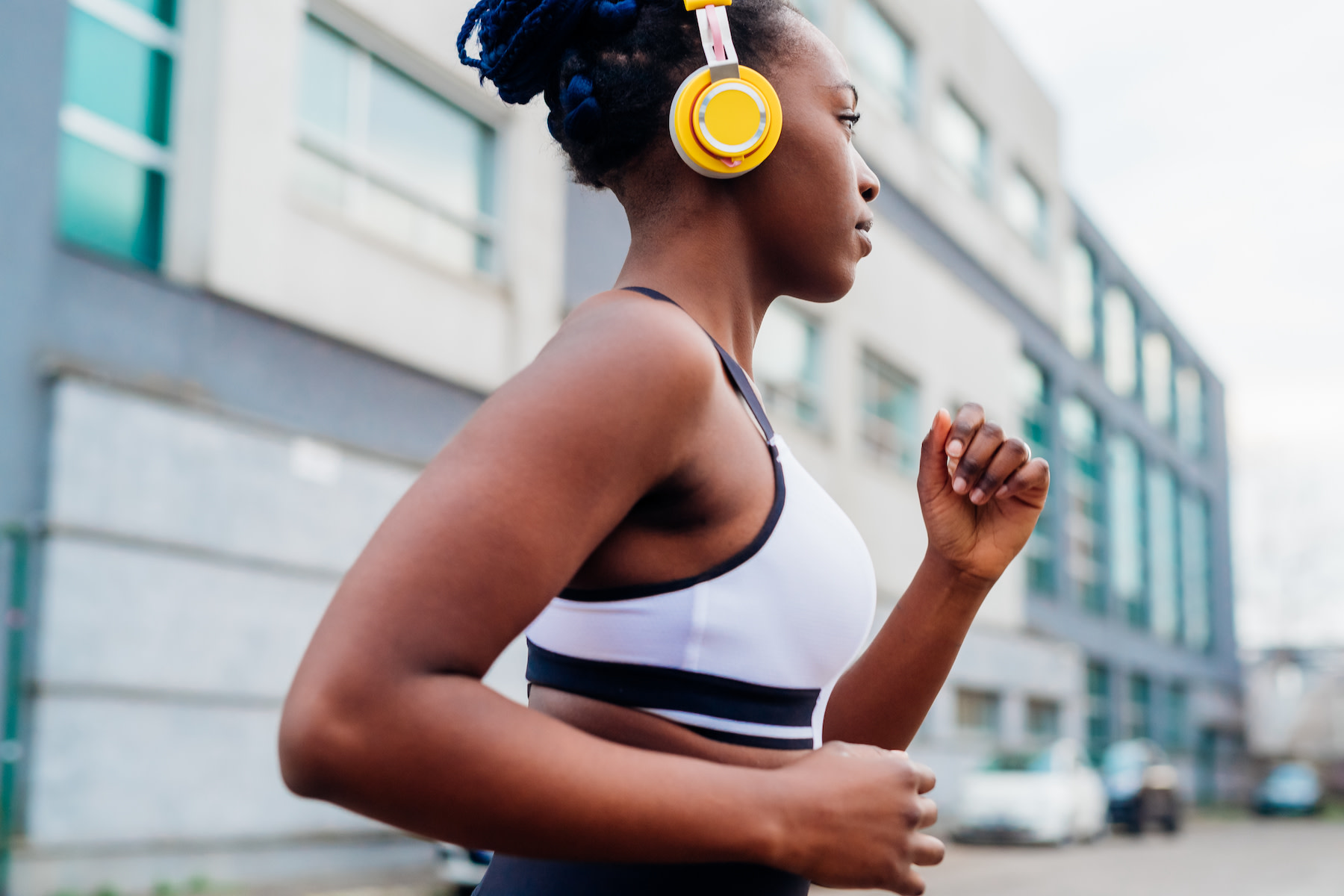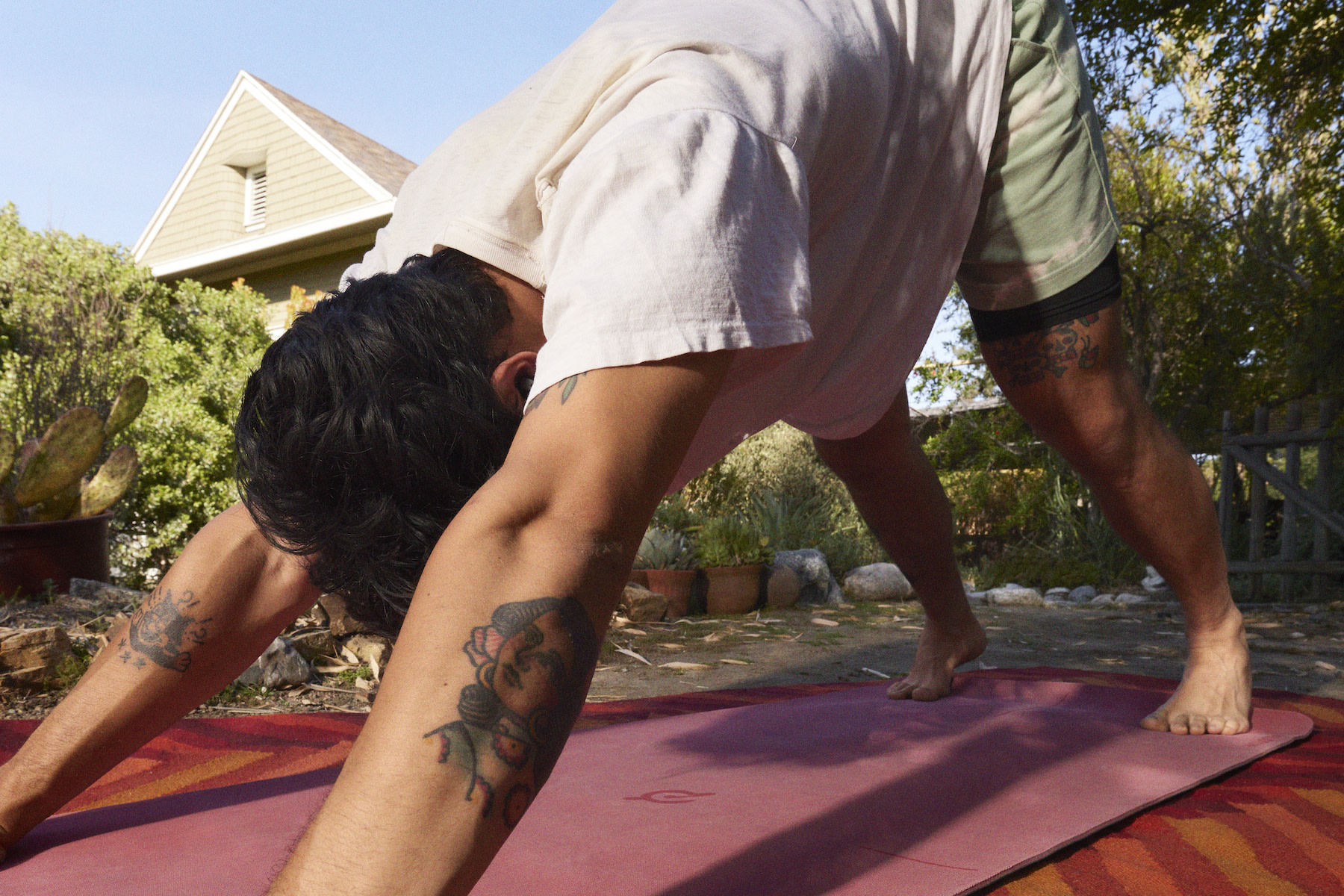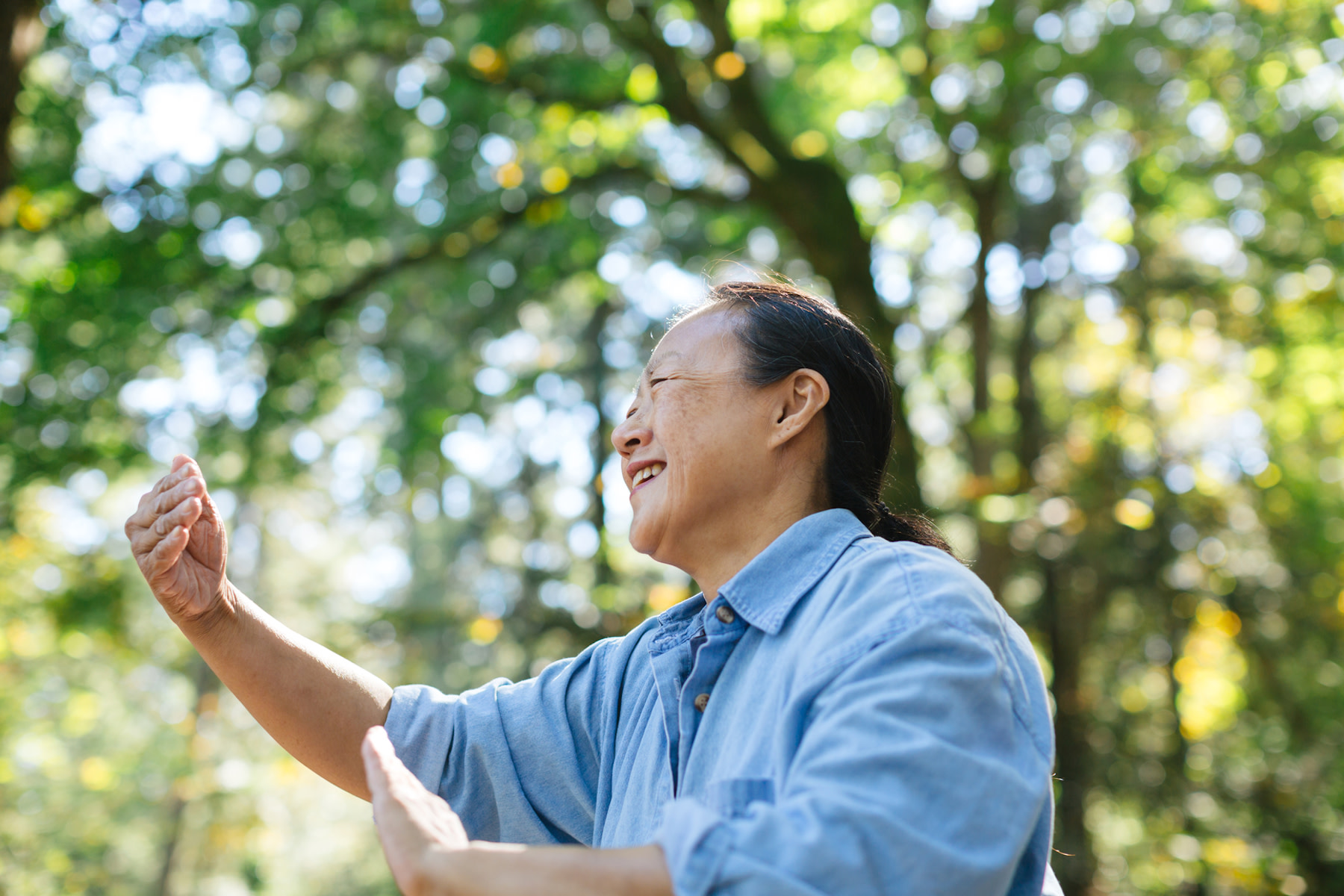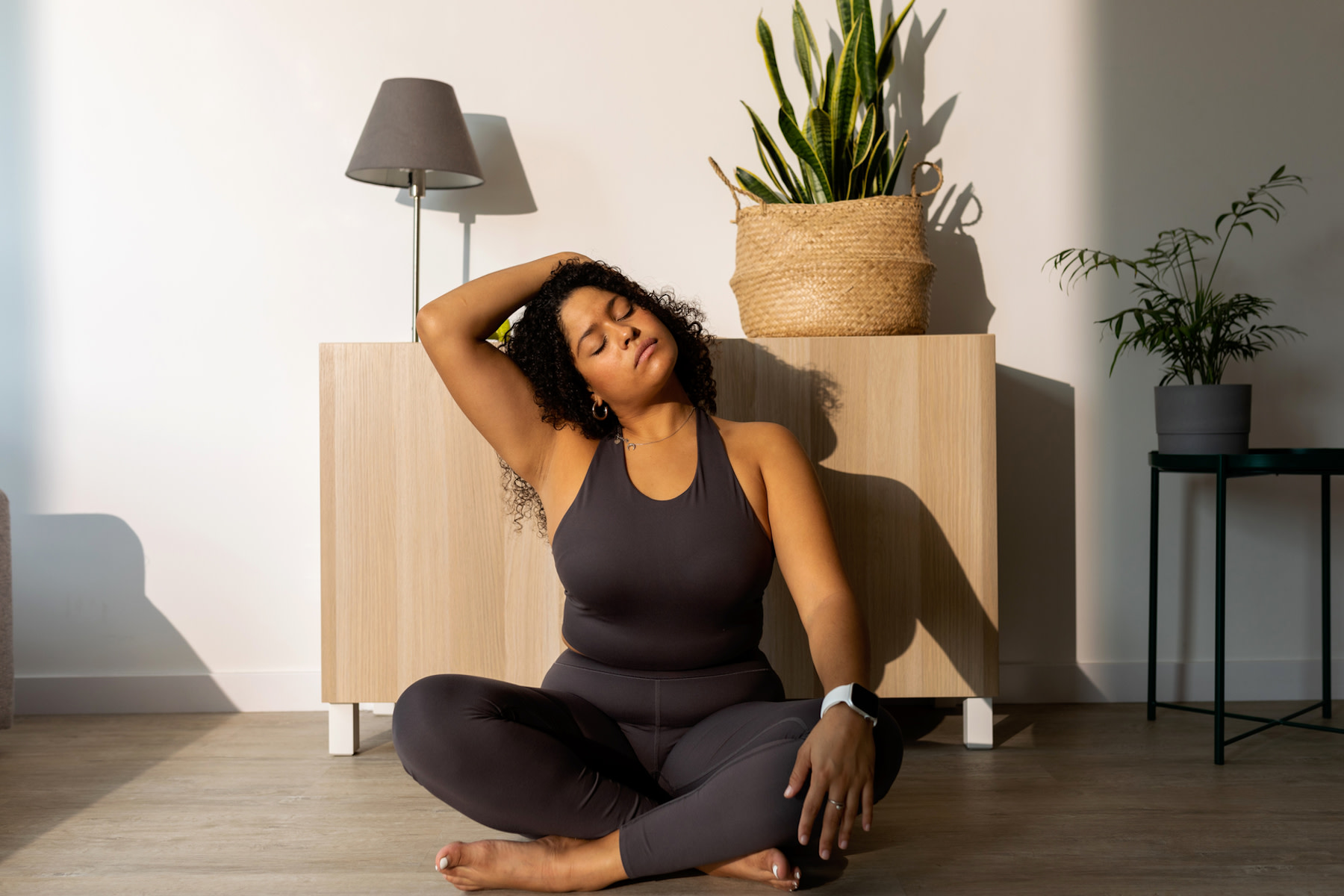
Eugenio Marongiu / Image Source via Getty Images
Turn Any Exercise Into a Mindful Movement Practice with These 6 Tips
Strengthen your mind-body connection by combining fitness and mindfulness.
By Jessica Migala•
What Is Mindful Movement?
Benefits of Mindful Movement Practice
Types of Mindful Movement
How to Make Any Movement Mindful
How to Incorporate Mindful Movement Into Your Daily Life
The Takeaway
If you’ve ever noticed the chirps of birds on a morning walk, settled into that thigh-burning feeling while doing squats, or matched one breath to one movement in yoga, you’ve already practiced a form of mindful movement.
Discover more ways to reach your goals with Peloton
There are many wonderful benefits of connecting your mind and body during physical activity. Whether you’ve never tried mindful movement before or want to deepen your practice, here’s what you can expect to get out of it, techniques for getting started, and how to start working it into your daily life.
What Is Mindful Movement?
Mindful movement simply combines mindfulness with physical activity. On its own, mindfulness is a form of meditative practice, defined by the American Psychological Association (APA) as an “awareness of one’s internal states and surroundings.” For example, if you’re applying mindfulness to washing dishes (it’s possible!), you’d focus on the sensation of the warm water on your hands, the tiny fizzes of soap bubbles popping against your skin, or how the lemon scent of the soap smells fresh.
Mindful movement, then, involves looking inward and paying attention to your physical feelings and emotions as you participate in physical activity. That might look like fixating on muscle contractions as you hold a plank, noticing the difficulty of an arm balance in yoga, or feeling the wind against your skin as you go for a run outside.
Overall, mindful movement is a practice that helps you strengthen your mind-body connection and helps you bridge the gap between mental and physical well-being. Some exercises lend themselves more fluidly to mindful movement than others (more on that later), but in general, mindfulness can be applied to any activity or workout.
Also worth noting: Mindful movement is something everyone can enjoy. As a 2015 research paper notes, mindfulness can be especially challenging for folks who find it tough to sit still and remain focused during traditional sitting meditation. Adding movement to a mindfulness practice can help quiet a running mind and bring enjoyment to the practice instead.
Benefits of Mindful Movement Practice
Mindful movement reconnects your mind and your body through physical activity (which, of course, is beneficial all by itself). Mindful movement allows you to hone in on the present moment and concentrate on what you’re doing. “When we move through life unconsciously, we are missing the magic in it and in ourselves,” says Peloton instructor Anna Greenberg.
Here are three benefits you can expect from starting or deepening a mindful movement practice:
1. Reduced Stress and Increased Resilience
Stressed much? A recent American Psychological Association poll found that about one-third of adults find stress “completely overwhelming” most days. That’s a huge burden to deal with on the regular, but mindful movement can help.
“Mindful movement is a powerful practice that can bring you back to yourself and where you are when things feel stressful,” Anna says. “It can make you feel whole and capable when you feel scattered and overwhelmed.”
Mindfulness can also shift your perspective, she adds. It won’t solve your problems, but it can help you see them in a new light.
2. More Self-Awareness
Life can move at warp speed, but with mindful movement, you’re asking yourself to slow down. “To me, the biggest benefit of practicing mindful movement is that it teaches us to be fully embodied in ourselves and the way we move through the world,” Anna says.
Fostering this sense of connection with yourself can help you make better choices for your mental and physical well-being because it forces you to listen to your needs. With the help of mindful movement, “we experience life more fully and set ourselves up for success in everything we do,” Anna says.
3. The Chance to Learn More About Yourself and Your Surroundings
The opposite of mindful movement, then, is living on autopilot—which, of course, is common given the constant busyness our world is built around. But there are drawbacks to living without consciously thinking about what you’re doing. “Operating on autopilot makes us more likely to have accidents, act in ways that are disconnected from ourselves, and miss opportunities big and small, from moments we could be cherishing to incredible discoveries we could be making about ourselves and the world around us,” Anna says.
For instance, maybe your mind is still zeroed in on work and you miss the gorgeous sunset splashed across the sky on your way home. That doesn’t seem like a big deal in itself, but these moments actually serve a function for our mental health. Taking time for experiences that provoke awe has been shown to promote well-being, suggests a 2019 Frontiers in Psychology study. Practicing mindful movement helps you stay better attuned to these awe-inspiring moments throughout your day.
Not only can mindful movement foster a better appreciation of the world around you, but it can also help you learn more about yourself, Anna points out. If you’re on autopilot, you might not hear an inner voice that’s whispering for you to try something new, take the risk, or trust your gut about a problem. Being in tune with yourself can help you better understand your wants and needs—and show up better for everyone around you.
Types of Mindful Movement
Any exercise can be mindful (as we explain below), but some activities purposefully create a connection between your mind and your body. A few common types of mindful movement include:
Yoga

“Practicing yoga is my personal favorite form of mindful movement,” Anna shares. “If you are brand new, taking a beginner class is a great place to start.” In yoga, you’ll learn how to pair your breath with your pose, which is a core component of mindful movement.
Walking Meditation

© Lauren Lee / Stocksy United
As its name suggests, walking meditation involves walking while in a meditative state, which can usher in a state of calm and groundedness. What’s more, it can help stop rumination and promote both mental and physical health. It’s also schedule-friendly since you can do a walking meditation on your way to work, while walking the dog, or during your lunch hour. (Psst: You can try expert-guided walking meditations on the Peloton App!)
Tai Chi

© Rob and Julia Campbell / Stocksy United
Tai chi is an ancient martial art that incorporates controlled breathing with slow movements and gentle postures, according to the National Center for Complementary and Integrative Health. It’s also easy on the joints, making it a practice you can enjoy throughout your life.
Stretching

© valbar STUDIO / Stocksy United
Stretching can be both relaxing and challenging. Sometimes, getting deeper into a stretch requires a focus on your muscles and your breath—making it another beginner-friendly form of mindful movement.
These activities are great examples of mindful movement to try, Anna says, because they’re not competitive or goal-oriented. Rather, “they’re focused on becoming present, connected, and fully embodied in the practice,” she explains.
How to Make Any Movement Mindful
Another wonderful thing about mindful movement? You don’t have to only do things like yoga or tai chi to take advantage of its benefits. If you enjoy other workouts—say, running, rowing, or lifting weights—you can make those part of a mindful movement practice, too.
“You can really transform any movement or activity into mindful movement by bringing your full awareness and presence to what you are doing,” Anna says. No matter what type of movement you’re engaging in, she recommends adding mindfulness by shifting your focus internally, which naturally increases your awareness of your surroundings and how you’re interacting with them.
But how exactly can you shift your focus inward? The tips below will help you get started.
How to Incorporate Mindful Movement Into Your Daily Life
Stepping into mindful movement can feel challenging at first (especially if you’ve never tried it before!), but follow these tips to help make it happen:
1. Schedule It
When planning a workout, you don’t simply hope that you’ll get it done that day. You decide exactly when and where you’re going to exercise, like lifting weights before work or jumping on the bike when you get home. Same deal here.
Mindful movement is great in that you can do it at any time and don’t need special equipment to get started. But it helps to plan to make it happen—otherwise, you might go through the motions of a workout and forget to bring your mind into it. For example, decide when you’re going to go on a walking meditation this weekend or dedicate one day per week to the type of yoga that you enjoy most, whether that’s vinyasa, hatha, or restorative.
2. Think About What Would Serve You
You can cater your activity to what your body (and mind!) need at that moment. Do you need time in the fresh air? Opt for a meditative walk. Is your body feeling stiff after a long day on the computer? Take time before bed to stretch your muscles while decompressing your mind.
3. Leave Distractions Behind
It's essential to remove distractions when you're cultivating mindfulness. There are some diversions you can’t control—like other people working out at the gym, a loud car zipping by, or your child asking you a question from upstairs—but focus on what you can dictate. During a mindful exercise sesh, skip things like podcasts or TV shows in service of being more present. (That said, a guided class can help you stay present and focused if you want some guidance.)

Peloton App
Access thousands of classes with no equipment needed.
4. Connect to Your Breath
As much as possible, bring your awareness to your breath as you move. Concentrate on the inhales and exhales and how they feel in your body. This will help you focus on staying present with where you are and what you’re doing. “I always come back to my breath as a tool to connect my mind and body when I feel disconnected,” Anna says. “Your breath is always there—you can come back to it anytime you need to anchor into yourself and the present moment,” she adds.
5. Bring Your Focus Back When It Drifts
You’ll be totally in tune with the experience one minute, and the next, your to-do list is all you can think about. That’s OK! You’re not doing it wrong, you haven’t failed, and you’re still reaping the benefits from your mindful movement practice. Besides, we’re not robots here—mind wandering is a human experience.
If and when your mind wanders, gently guide it back—but don't get mad at yourself for getting distracted. "Remember, it’s called a 'practice,' not a 'perfection,'" Anna says. And on that note...
6. Observe Your Experience Without Judgment
It’s normal to feel self-critical, especially when you’re working toward an athletic goal. You may judge yourself for feeling gassed on a climb on the bike, not running fast enough, or falling out of the headstand that you’ve been working on for weeks in yoga. All of those moments can produce ‘not good enough’ thoughts, but mindfulness is about freeing yourself from judgment. Try to notice when negative self-talk is happening and remind yourself that you’re showing up today exactly as you should be—and that’s more than enough.
The Takeaway
Mindful movement combines mindfulness with physical activity to create and deepen your mind-body connection, which can aid in stress reduction, improved resilience, and self-awareness. Although mindful movement naturally lends itself to activities like yoga, walking meditations, and tai chi, it can be applied to any exercise as long as you pay attention to your breath and turn your focus inward.
This content is for informational and educational purposes only and does not constitute individualized advice. It is not intended to replace professional medical evaluation, diagnosis, or treatment. Seek the advice of your physician for questions you may have regarding your health or a medical condition. If you are having a medical emergency, call your physician or 911 immediately.
This content is for informational and educational purposes only and does not constitute individualized advice. It is not intended to replace professional medical evaluation, diagnosis, or treatment. Seek the advice of your physician for questions you may have regarding your health or a medical condition. If you are having a medical emergency, call your physician or 911 immediately.
Level up your inbox.
Subscribe for a weekly dose of fitness, plus the latest promos, launches, and events.
By providing your email address, you agree to receive marketing communications from Peloton.
For more about how we use your information, see our Privacy Policy.





